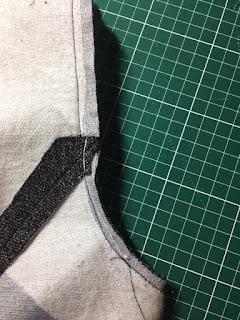A few notes on the pattern and the changes I did:
- the pattern is for tall people and while I'm not 1.76 (the lenght the tall patterns are drafted for) I'm closer to that than to the average length of 1.68 of their regular patterns. I chose the size by waist circumference, hoping the pleats would give the extra room at hip height. Without any other changes, it was a miraculously good fit.
- in the magazine 2 variations are shown, one with the pleats folded to the center front, one with the pleats folding to the sides.
On my first pair, I hadn't noticed this, nor read the instructions and had folded the pleats to the side because that's more common. Sewing on auto-pilot. Though fine, I preferred the pleats to be a bit more away from the center, so I moved the pleats 1.5 cm to the side on my second pair. The photos are of the pair with this change. - Earlier this year I made a pair of trousers from the March issue, which had a slightly curved pocket opening which didn't gape. So I used that slight curve here too.
When sewing the pocket, I used a strip of silk organza to take out any stretch. - I made the legs a normal length and didn't add cuffs.
- Almost forgot: changed the straight waistband to a curved one. Straight waistbands don’t suit me. It’s not difficult to draft a new one, but I made my life easy when I was amongst my sewing friends. One of the ladies had just traced a pattern with a curved waistband. I made a copy, adjusted a bit on the length for my pattern and that was it. The happiness of sewing friends!

In my opinion a little basting helps to get a better result.

I know there are still pleats in the back, it's different with every move. I think I can't get it much better than this.


















































